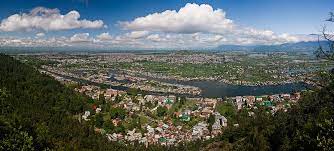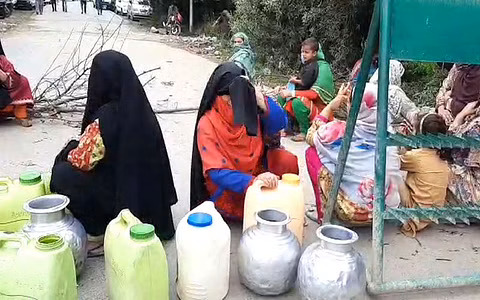Ensure implementation of Climate Resilient City Action Plan for the summer capital
By: Arif Shafi Wani
Blessed with lakes, wetlands, gardens and mountains, Srinagar is one the major tourist attractions in Jammu and Kashmir. However, haphazard development, especially in past over three decades, has disturbed eco-system of the bustling city.
Spread over 246 sq.km, Srinagar is the largest populated city in J&K with a population of 1.50 million people. The city is the main hub of tourism and trade activities.
For centuries, Srinagar has been the abode of all rulers given its unique historic and geographic characteristics. Owing to its unique topography, the city is prone to natural disasters especially floods and earthquakes.
It is ironic that despite falling under the high seismic Zones IV and V, haphazard constructions were allowed in fragile areas including flood plains, wetlands and agricultural fields in Srinagar.
It is shocking that 20 wetlands have been buried under urban colonies during the last over three decades south of Srinagar.
Ecologically important wetlands in Srinagar’s Jhelum floodplains including Hokersar, Bemina, Narakara, Batamaloo numbal, Rakh-e-Arth have been degraded due to rapid encroachment and urbanisation.
These eco-fragile areas were an important part of Srinagar’s eco-system and helped to prevent flooding. Now only concrete structures are visible.
Srinagar faced the brunt of devastating floods on September 7, 2014. Most of the water bodies in the summer capital especially Aanchar, Gilsar, Khushalsar and Brari Nambal are on the verge of extinction in absence of conservation measures.
Many areas in Srinagar face frequent water-logging as the natural drainage system has been filled and buried. In a sheer example of unplanned development, several factories having high pollution emissions have been allowed in eco-fragile zones including Khrew on city outskirts. The area is close to Dachigam National Park which is home to several endangered species including Hangul.
So how to save this city, which is a repository of our history and culture, from further destruction? It is difficult but not impossible. As per estimates, the population of Srinagar is estimated to go upto 2.1 million in 2031.
It will grow 0.53 times by year 2051, having a projected population of about 3.2 million. Land is becoming scarce in the city and in this scenario vertical development is important.
More than Smart City projects, which focus more on beautification, there is a need for scientific planning to ensure balance between nature and development. Many believe that the Master Plan for Srinagar lacks vision to face natural disasters and prepare Srinagar for futuristic needs.
Authorities have been silent on how floodplains of Jhelum including Mehjoor Nagar, and wetlands in Peerbagh, Bemina, HMT and Qamarwari areas have been converted into full-fledged colonies.
Who allowed the filling of Nallah Mar which was vital to maintaining hydrology of Dal Lake; it paved the way for its deterioration? Most of the parks in the city are in shambles.
Trees including Chinars are facing the axe in the name of so-called development. We are fast losing green cover. In the last several decades, Srinagar has been marred by official apathy and public greed. City’s natural resources are overstressed.
Indicators of climate change in Srinagar are clear. On June 23, Srinagar recorded its hottest June day after 18 years at 35.0 degree Celsius. This matches the previous record set on June 3, 2018, when the temperature also reached 35.0°C.
Despite having abundant water resources, Srinagar is facing acute shortage of drinking water. This year, May and June witnessed unprecedented heat conditions in the city. There has been over 80 percent rainfall deficit recorded in Kashmir including Srinagar in August. India Meteorological Department’s), states that Srinagar district was severely dry with an Standardized Precipitation Index (SPI) value of -1.73 last month.
There has to be a sustainable plan for the development of Srinagar. The Department of Ecology, Environment and Remote Sensing, (J&K), in association with the United Nations Development Programme (UNDP) have prepared this Climate Resilient City Action Plan (CRCAP) for Srinagar City. This plan is important to mitigating climate change and increasing the climate resilience of Srinagar.
Srinagar city’s future climate under SSP-245 scenario suggests the accumulated rainfall is projected to increase by 55 mm/yr in near future and by 85 mm/yr in far future. In the SSP-585 scenario the accumulated rainfall is projected to increase by 87 mm/yr and 225 mm/yr in near and far future respectively.
Under the SSP-245 scenario in near future the maximum and minimum temperature is projected to increase by 1.22°C and 1.25°C respectively. In far future, under the SSP-245 scenario the maximum and minimum temperature is going to increase by 2.51°C and 2.48°C respectively.
Under SSP-585 scenario in near-future the maximum and minimum temperature are projected to increase by1.42°Cand 1.47°C respectively while the upsurge is on the higher end by 4.30°C and 4.51° C in the far-future.
As per the CRCAP report, the climate risks were analysed by performing a vulnerability assessment that looked into Srinagar’s vulnerabilities.
The analysis showed that 74.05sq km (30.18% ) of the municipal area is exposed to floods with water depth ranging from 0.66 m to 2.15 m. The assets that were exposed to floods were estimated to be 23 percent of substations (power sector), 27 per cent of Telecommunication sector, 18 percent of sewerage network and 27.6 per cent of road network are exposed leading to CIs at risk and other critical infrastructure such as health, schools, water, solid waste management and fire stations.
Cumulative composite assessment states the most vulnerable ward is 53, Buchpora, with two per cent of the total population.
To reduce vulnerabilities, future growth strategies to facilitate a low impact development in these locations needs to be incorporated along with a climate resilient and low carbon growth strategy to ensure minimum exposure to the people, it states. To accomplish the same, energy sector emissions are to be taken into account for fuel combustion from transport, industries, agriculture, commercial, and residential categories.
It was found that emissions from the energy sector increased at CAGR of ~0.84% from 456.51 kt CO2e in 2005 to 513.37 kt CO2e. The energy emissions of Srinagar city accounted for ~80% of the economy-wide emissions.
Energy sector, transport category were the major contributors to the GHG emissions with a share of ~62% in the total energy emissions followed by residential and agriculture categories with shares of ~26% and ~8% , respectively.
The Energy sector was the major contributor of GHG emissions in Srinagar city’s total economy-wide emissions contributing an average of 80% to economy-wide emissions.
The CRCAP is a comprehensive scientific plan to estimate greenhouse gas emissions, identifying vulnerability hotspots, and understanding critical infrastructure systems with respect to resilience. It is designed to develop specific climate change mitigation and adaptation plans while promoting sustainable development.
CRCAP facilitates formulating policies at city and ward levels with the goals at global level. The CRCAP- Srinagar envisions a city where its communities and citizens are safer, healthier, and thrive even in a changing and uncertain climate. The CRCAP is committed to a net zero and climate-resilient Srinagar by 2050.
It is the responsibility of both Government and People to help in implementation and success of CRCAP action plan for Srinagar. It is high time for stakeholders to save the unique character of Srinagar and preserve its natural resources and historic character for future generations. Source
The article’s content, excluding the headline, has been directly taken from a third-party syndicated feed without any modifications or editing by the Kashmir InFocus staff.






